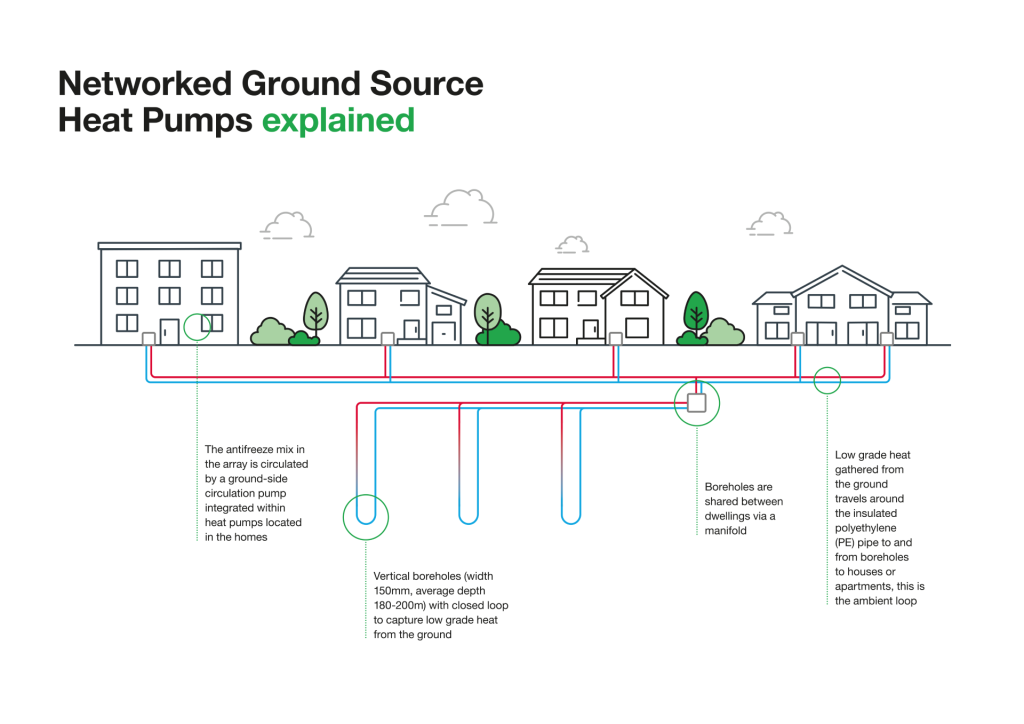By Neal Herbert, GTC Managing Director

The Old Guard – Gas Boilers in a New Home
In the world of residential development, there’s comfort in familiarity. For decades, developers have relied on gas boilers to heat new homes. They’re simple, well-understood, and easy to install. Plumbers know them inside and out. Logistically, they’re compact – six boilers to a pallet – making on-site storage a breeze. And from a cost perspective, they’re a winner.
Homeowners too are comfortable with gas. Boilers are tucked neatly into kitchen cupboards and are easy to maintain, thanks to a robust national network of service providers like Homeserve. Repairs are straightforward, and energy bills, while not always cheap, are at least predictable.
But the world is changing. The demand for sustainable solutions and reduced carbon emissions is pushing the industry towards greener alternatives.

The Transition – Air Source Heat Pumps
As gas boilers begin to fall out of favour, individual air source heat pumps have emerged as the next step. On paper, they sound ideal. They’re more energy-efficient – delivering up to three units of heat for every unit of energy used – and they align with sustainability goals.
But the reality is more complicated.
Installing air source heat pumps isn’t plug-and-play or fit and forget. They require different plumbing infrastructure, which means extra training and time. They’re also logistically cumbersome – each unit takes up the space of three pallets, increasing transport and storage needs. Installation sites must be carefully chosen, often impacting the external aesthetics of a home, particularly in terrace builds.
For homeowners, while the efficiency is an upgrade from gas, bills can still be high in winter. Repairs may also be harder to source, given the relative lack of industry expertise and knowledge.
Here today – Networked Ground Source Heat Pumps with Smart Technology
Enter the game-changer: Networked Ground Source Heat Pumps.
These systems are designed to overcome the limitations of both gas and air source heating. Installed underground with the indoor unit conveniently located inside the home – often under the stairs or near the hot water tank, Networked Ground Source Heat Pumps provide a familiar and space-saving setup for developers and a discreet, efficient solution for homeowners.
For developers, the advantages are compelling:
- 15 units per pallet, drastically reducing transport and on-site storage.
- Lower costs compared to individual air source heat pumps.
- Simplified electrical infrastructure, with demand on par with gas boilers with no costly reinforcements or substation upgrades needed.
- Bring a complete end-to-end heating, hot water and cooling solution. This inclusion of passive cooling helps Part O Building Regulation compliance.
For homeowners, the benefits are even more persuasive:
- 4:1 efficiency, year-round.
- Uncompromised performance in cold weather – unlike air source heat pumps, ground source heat pumps don’t struggle in winter.
- 30% reduction in energy bills, thanks to a bundled smart thermostat.
- Low maintenance, with all parts and servicing – including boreholes – covered by GTC.
- Remote control, learning behaviour, and seamless integration via the smart thermostat app.
It’s a true “fit-and-forget” system, backed by UK manufacturing, lifetime guarantees, and a domestic customer service centre. And yes—it’s fully Future Homes Standard-compliant and eligible for Greener Grid Payments, meaning it’s good for the planet and your pocket.


